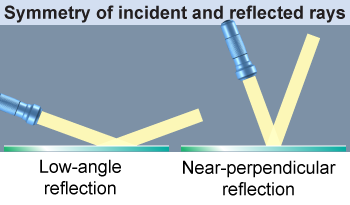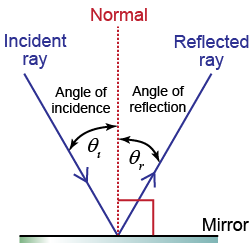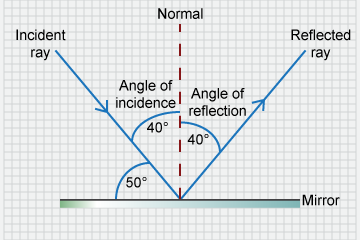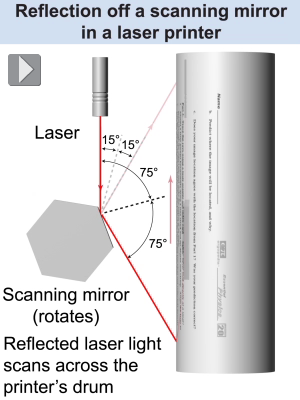|
 The diagram on the right shows how a flashlight beam reflects from a flat mirror. If the beam approaches at a low angle the reflected beam also leaves the mirror at a low angle. If the flashlight beam approaches nearly perpendicular to the mirror the reflected beam is also nearly perpendicular to the mirror. Reflection shows symmetry of angles between the incident and reflected beams.
The diagram on the right shows how a flashlight beam reflects from a flat mirror. If the beam approaches at a low angle the reflected beam also leaves the mirror at a low angle. If the flashlight beam approaches nearly perpendicular to the mirror the reflected beam is also nearly perpendicular to the mirror. Reflection shows symmetry of angles between the incident and reflected beams. 
|
 Reflection is symmetric in angle. Therefore, to describe reflection we start by defining angles. The normal is an imaginary line drawn perpendicular to the reflecting surface at the point of intersection with the incident ray. All angles are defined relative to the normal.
Reflection is symmetric in angle. Therefore, to describe reflection we start by defining angles. The normal is an imaginary line drawn perpendicular to the reflecting surface at the point of intersection with the incident ray. All angles are defined relative to the normal.
| θi: | The angle of incidence is the angle between the incident ray and the normal. | | θr: | The angle of reflection is the angle between the reflected ray of light and the normal. | The law of reflection states that the angle of incidence equals the angle of reflection (equation 20.3). 
 |
If the law of reflection is true—that the angle of reflection equals the angle of incidence—then how does diffuse reflection occur? Diffuse reflection of an incident light ray in a translucent material occurs through a combination of scattering by an uneven surface and scattering from a series of reflections at different angles underneath the surface. Many materials can be described as having irregularly shaped structures, whether as a result of crystalline defects, cell membrane walls, or other physical features. At each of those subsurface interfaces, the law of reflection might be obeyed in the reflection part of the incident ray’s light. Since those interfaces occur at many different angles, however, the effect is that an incident ray is reflected into many different directions; i.e., the incident light is scattered. It is important to model this subsurface scattering to render realistic-looking surfaces in computer animations, such as for video games or feature films. 
|
| (20.3) | | | θi | = | angle of incidence (degrees) | | θr | = | angle of reflection (degrees) |
| Law of reflection
|
|
- Draw the incident light ray,
- Draw the normal to the surface at the point of contact,
- Determine the angle of incidence,
- Draw the reflected ray on the other side of the normal line, such that the angle of reflection equals the angle of incidence.


|
When solving reflection problems, the first step is to draw the normal at a 90° angle to the surface at the point of reflection. The most common source of confusion is mistaking the angle between the incident light ray and the surface of the mirror with the angle of incidence—which is between the incident light ray and the normal to the surface. 
|
A light ray strikes a flat mirror at an angle of 50° to the mirror surface. Draw a ray diagram for the incident and reflected light rays. Label the angles of incidence and reflection and the normal. 
|

| Asked: | a ray diagram | | Given: | angle between the incident ray and the (flat) mirror, 50° | | Relationships: | θi = θr | | Solution: | From geometry, the angle of incidence is
θi = 90° − 50° = 40° From the law of reflection, the angle of reflection is also 40°. |
 |
 In a laser printer, the beam of light from the laser is used to “write” the text onto the photoconducting drum. The laser itself is fixed in place, so a scanning mirror is used to move the laser light horizontally across the drum. The scanning mirror is typically of hexagonal shape, with six flat mirrors mounted on the side of each of the hexagon’s faces. The scanning mirror spins continuously in one direction. As the mirror turns, the angle of incidence changes—causing an equal change in the angle of reflection (owing to the law of reflection)—diverting the light as a result. As the mirror moves the laser’s beam across the drum, the laser’s light is also turned on and off by the computer controller. The on and off pattern of the laser light striking the drum causes charge to be removed from some places and not from others—the negative image of the page that is being printed.
In a laser printer, the beam of light from the laser is used to “write” the text onto the photoconducting drum. The laser itself is fixed in place, so a scanning mirror is used to move the laser light horizontally across the drum. The scanning mirror is typically of hexagonal shape, with six flat mirrors mounted on the side of each of the hexagon’s faces. The scanning mirror spins continuously in one direction. As the mirror turns, the angle of incidence changes—causing an equal change in the angle of reflection (owing to the law of reflection)—diverting the light as a result. As the mirror moves the laser’s beam across the drum, the laser’s light is also turned on and off by the computer controller. The on and off pattern of the laser light striking the drum causes charge to be removed from some places and not from others—the negative image of the page that is being printed.
Movable mirrors are often used in optics to control the direction for a laser because it is easier to tilt a small mirror than to move a laser itself. Stereolithography is another manufacturing technique that uses a movable mirror to redirect laser light. 
|
A light ray hits a mirror at an angle of incidence of 35°. What is the angle of reflection? - 0°
- 35°
- 55°
- 70°
 |
The correct answer is b. By the law of reflection, the angle of incidence (θi) is equal to the angle of reflection (θr). 
|
A light ray perpendicular to the surface of a mirror strikes it. What is the angle of reflection? - 0°
- 45°
- 90°
- 180°
 |
The correct answer is a. When a light ray is perpendicular to the surface, its angle of incidence is 0°. Since the angle of reflection equals the angle of incidence, the angle of reflection is therefore also 0°. 
|

